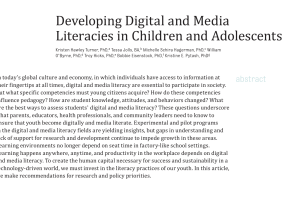Abstract
In today’s global culture and economy, in which individuals have access to information at their fingertips at all times, digital and media literacy are essential to participate in society. But what specific competencies must young citizens acquire? How do these competencies influence pedagogy? How are student knowledge, attitudes, and behaviors changed? What are the best ways to assess students’ digital and media literacy? These questions underscore what parents, educators, health professionals, and community leaders need to know to ensure that youth become digitally and media literate. Experimental and pilot programs in the digital and media literacy fields are yielding insights, but gaps in understanding and lack of support for research and development continue to impede growth in these areas. Learning environments no longer depend on seat time in factory-like school settings. Learning happens anywhere, anytime, and productivity in the workplace depends on digital and media literacy. To create the human capital necessary for success and sustainability in a technology-driven world, we must invest in the literacy practices of our youth. In this article, we make recommendations for research and policy priorities.
This article was published in a special 2017 supplement of Pediatrics, a journal of the American Academy of Pediatrics. The supplement, “Children, Adolescents and Screens: What We Know and What We Need To Learn,” was produced by Children and Screens and includes the contributions of more than 130 interdisciplinary authors across 22 papers. See a complete list of articles included in the supplement.
